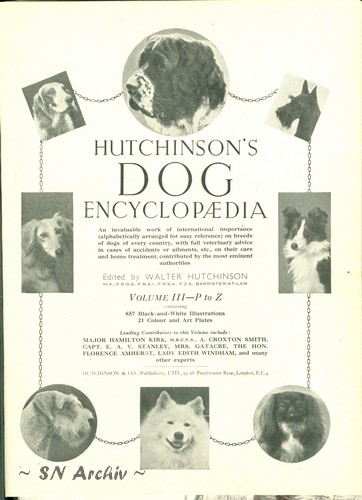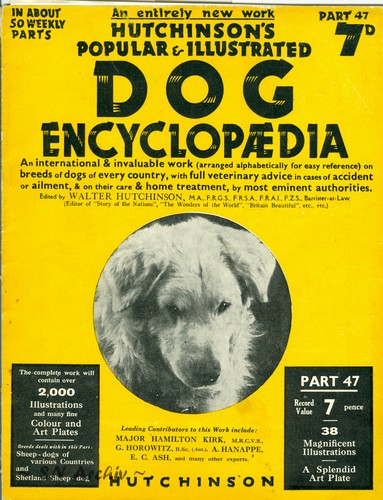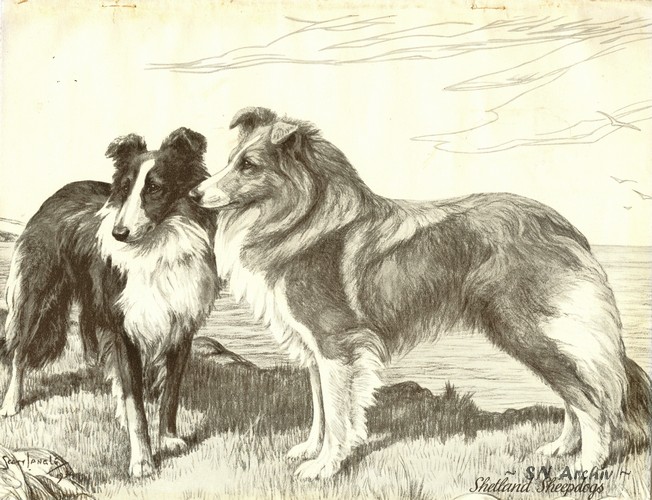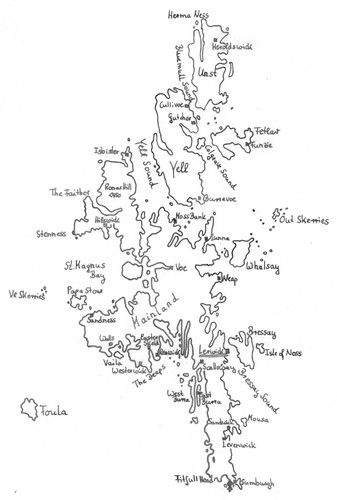  |
HUTCHINSON's DOG ENCYCLOPAEDIA - Volume III - P to Z and HUTCHINSON'S Popular & Illustrated DOG ENCYCLOPAEDIA - Part 47 7D edited & published by Walter Hutchinson, M.A., F.R.G.S., F.R.S.A., F.Z.A., Barrister-at-Lawotsdam (GB), 1934-1935 |
This work(s) not only contain(s) a detailed description of the early Shetland Sheepdog including its origin, it (they) also give a good summary of the type religious-war of this time and its background. In addition to the enumeration of important show dogs and breeders, there are numerous photos of typical breed representatives of their time, giving a good overview of the Shelties of the 20s and 30s.
Page 1693-1705: "Shetland Sheep-dog. - The Shetland Sheepdog is an attractive miniature, or rather a smaller species of one of the most beautiful of British breeds, the Collie of Scotland, which less than fifty years ago was the most popular of all dogs and fetched record prices. In those days small fortunes changed hands, and the dogs steadily improved in type and coat. There were then two types, the original working Collie from which the show Collie had been evolved, and the improved dog, the show Collie.
Similarly there are two distinct types of Shetland Sheep-dog, but both are registered under the same name, a fact which has led to considerable difficulty and argument. The one variety is very like the Collie dog of the eighteenth and early nineteenth centuries, before the days of registration, and the other is a miniature of the show Collie type that made record prices when Megson, the Rev. Hans Hamilton, Stretch and others bred, bought and sold them.
This rather unfortunate state of affairs has divided the breeders into two camps, and it is to be regretted that it did not at the same time divide the dogs, for that would have solved the problem to the advantage of both parties. However, it was decided to continue to run the two different types together, thus utterly confusing judges, breeders and the public, making the situation most unsatisfactory for all concerned.
The late Dr. Bowie, of Bixter, Shetland, and others maintained that the breed should be continued in the form in which it had been discovered on the island, namely, as a working Sheep-dog of working Collie type, not, as Dr. Bowie put it, 'as a miniature show Collie'. He and those who agreed with him showed their Shetland Island dogs at the leading shows amongst the miniature Collies, and it depended on the view of the judge as to which type was preferred. The only thing a judge could do was to go by the standard of description, in which case he would have been compelled to ignore the island type, and give prizes to the miniature Collie, unless he interpreted the word 'Collie' in some other way.
This may not at first glance be clear, but it must be born in mind that when the Collie is referred to to-day, it is no other than the show Collie as registered in the Kennel Club Stud Book.
As to the island type, it must be admitted that they varied; some where much more Collie-like than others, and might well have been described as short faced, nearly fox-faced dogs. Those of Collie appearance varied also; some were Collies similar to the forebears of the Collie breed, and some approached the ideal of the boom days of the larger breed.
One of Dr. Bowie's favourite dogs was 'Hildasay Viking', the winner of the Stud Dog trophy at the Shetland Sheep-dog Society's Show, a dog unbeaten at the Shetland Shows, and first at Inverness, but which, on coming to Cruft's, was placed third. A typical old-world Collie in miniature, it was a dog of very much better type than many of the island dogs; in fact it was the kind of dog seen on mainland farms to-day, except that it was much smaller - it was the shepherd's Collie.
Dr. Bowie contended that there was no justifiable reason for making the island breed into a show Collie, a variety which had nothing whatsoever to do with the island. To this the breeders of the miniature show Collie replied that the island dogs were mongrels, and if left in such a condition it was not only impossible to have a standard for them or to judge them, but that they actually do not constitute one breed but a number of breeds. They also said that all they were doing was to build up from these dogs worthy representatives of the family. The breeders of the working dogs felt that the name of 'Shetland Sheep-dog' applied exclusively to the island breed, and that the name should not be used for a miniature Collie. As all this was bad for both breed and breeders, it was suggested that a division should take place and that each should have its own classes, but nothing came of it, and classes at shows remained a mixed collection of the most beautiful show Collies and the attractive and useful Collie Sheep-dogs from the island.
Then, as if matters were not already bad enough, some of the breeders of the show Collie type evolved a Collie Toy-dog, which appeared in the Shetland Sheep-dog classes, and which although quite unsuitable for work, was a amost attractive and charming variety, which, as a Toy-dog, would have found many admirers. But through the failure to divide and make two breeds of these varieties, one of the other was bound to become eliminated, and that might have been avoided.
The arrival of the breed on the mainland occured some years before the war. Tourists visiting the Shetlands were greatly intrigued by the small Collie-like dogs which were helping the shepherds, and they purchased some of them. They were part of the island life, as were the small cattle, the diminutive ponies and sheep. There was little to be gleaned about their history. All that could be said was that the dogs had been on the island as long as man could remember. They had probably originated from Collies brought over from the mainland, before the boom; and then there were those who would have it that the climate had dwarfed the dogs and those who insisted they had interbred with Terriers or other smaller dogs. But Sheep-dogs were wanted, and by a process of selection the dogs of Collie type had been retained. Little or no attempt was made to fix a type, and no one had bothered much about their colour or marking, length of head or coat, or such a thing as 'Collie expression', all of which meant nothing to their owners, who were interested only in one quality, usefulness.
Whilst tourists to the island took back to the mainland with them some of these small Sheep-dogs, on the island a number of dog-lovers and fanciers got together and decided to establish the dog as a breed and register it in the Kennel Club Stud Book. So in 1908 a meeting was held at Lerwick, the capital of the Shetlands, and a club known as 'The Shetland Sheep-dog Club' came into being. There had been much talk of calling the breed 'The Shetland Collie' and the club 'The Shetland Collie Club' - but the Collie Club of Great Britain was definitely adverse to the breed taking that name, for the dogs were then of the island type, and they therefore hardly conformed to the generally accepted idea of a Collie dog. The following year another club was formed, 'The Scottish Shetland Sheep-dog Club', and it was follwed by a club named 'The British Shetland Sheep-dog Breeders Association' and 'The English Shetland Sheep-dog Club', clearly showing the strive that was rending the breed, dividing the handful of breeders who held diverse opinions and breed ideals.
In the years that followed two of the three clubs survived.
In 1909 the Kennel Club agreed to recognize the breed as a distinct variety of a show Collie type, not to be more than 12 inches high, which was later altered to 13 1/2 inches, possibly as the 12-inch limit favoured the Toy.
Amongst others who had taken up the breed were Messrs. Thompson, Clark, Loggie and Hoggan, and amongst women breeders Mrs. Ashton Cross and Mrs. Hunloke. The year 1909 is one to be remembered in the annals of the breed, for it was the first occasion of a class for Shetlands having been provided for at Cruft's Show; no Challenge Certificates were, however, offered by the Kennel Club.
In 1915 the first Challenge Certificates where offered and the first Champion of the breed was 'Clifford Pat', born in 1914 and owned by the Misses E. Dawson and J. Wilkinson. 'Clifford Pat' went back to 'Lerwick Jarl' and 'Lerwick Siguard' and was well shown. As it was the first Champion of the breed, its show career is of interest.
It won First at Cruft's in the Open class and also in the Limit class. At Richmond it was best bitch [M.F. remark: C. Pat was a male] in the Open and Limit clases. At Hastings it won Second in both Open and Limit classes, and at Kensington Championship show, First in the Open.
Miss B. Thynne, who was to become one of the leading breeders of Shetlands, showed her 'Woodvold', bred by Messrs. Keith and Ramsay, in 1913, the dog also going back to 'Lerwick Jarl'. On the show bench at Championship Shows was seen the Misses Dawson's 'Phoebe of Pix Hall' and 'Frea', bred and shown by Mrs. B. Huband, which also went back to 'Lerwick Jarl', while Miss M. Grey showed 'Erica'. The following year Miss Thynne's 'Woodvold' became a Champion. The Great War put an end to activities, although, owing to its small size, it did not suffer as much as the larger breeds. At the 1914 shows few dogs appeared. Miss B. Thynne showed her 'Caliph of Kilravock', 'Iona Modee', 'Kilravock Spriggie' and 'Eureka; in fact, all the prize winners at Championship Shows were owned by her. 'Nettle of Mountford' became a Champion, while 'Freshfield Fad' win the largest number of prizes and its Championship for Mrs. T. Harrison.
The year 1923 showed a great increase in honours won by this breed, and the registration increased to 258.
It is an interesting fact that thirteen out of the nineteen winners at Championship Shows were sired by unregistered dogs or out of unregistrated bitches. The nineteen-twenties saw a return of happier days in the dog world. No Champions appeared amongst the winners at Championship Shows, but 'Hurly Burly' won its first Challenge Certificate and 'Walesby Select' did the same. Forty-two members of the breed were registered in that year, and that figure was nearly doubled the following year.
The success of the Shetland Sheep-dog was assured by the beautiful miniature Collies seen at the more important shows. Miss C. Bowring, Miss Dering, Miss E.P. Humphries and Mr. E.C. Pierce were amongst the leading exhibitors, and the Champions 'Hurly Burly' and 'Eltham Park Petite' (the latter bred and shown by Mr. Pierce) were interesting exhibits. Other great Champions were 'Walesby Select' and 'Specks of Mountford', the latter bred in 1922 by Mr. D. MacGregor; it had that highly favoured colouring, sable and white. There also appeared those charming little dogs Ch. 'Freshfield Fad' and Ch. 'Nettle of Mountford', bred by Miss E. P. Humphries and shown by Miss Thynne.
Mr. Pierce's 'Winstonian Pixie' was exhibited by Mr. A. R. Cox, and Miss Thynne showed 'Eltham Park Perfection', a son of Ch. 'Specks of Mountford'. Miss Thynne also won with her Ch. 'Kilravock Nettle' and with her 'Goldfinder', and Mr. W. M. Saunders with his 'Farburn Advance'; Mr. Pierce's 'Eltham Park Erling' won in competition with the rest.
Another Kennel of importance in the show ring was run by Mr. M. C. Tod, whilst Mrs. I. Warren showed her winning bitch 'Karem', and her great Champion dog 'Euan of Clerwood', while Mrs. J. H. and Miss P. M. Allen exhibited their great winning bitch Ch. 'Tilford Tinette'.
Next on scene arrived the 'Peabody' dogs, shown by Miss E. Peabody Montgomery, her 'Panache' winning its Championship in 1931. The next year Ch. 'Lochinvar of Clerwood' and 'Eltham Park Elyned' became the most important dogs in the breed. 1933 saw Mr. and Mrs. C. Campbell's 'Tilford Tay' winning Challenge Certificates, as did also Mr. R. H. Taylor's Ch, 'Wish of Wyndora' and Mrs. E. Baker's Ch. 'Pea Blossom of Houghton Hill'.
It would be difficult to say which dogs have done most to help the breed, and their advantages will always be a matter of dispute. It is, however, claimed that Ch. 'Specks of Mountford' was the most important of all sires, and that it was thanks to this dog that the show Collie tyoe became so firmly fixed.
It is also said that as examples of the most desired type Ch. 'Eltham Park Petite' was one of the best, as also was Ch. 'Eltham Park Esme', owned by Miss Frederica Fry.
Breeders were anxious to keep the true Collie type free from any Borzoi influence, and it is very fortunate that the breed had amongst its fanciers people who were interested in the Collie.
The show points of the breed, as accepted in England, make it clear that the head and expression are of supreme importance, the skull of the dog to be as nearly flat as possible, moderately wide between the ears and tapering towards the eyes, with only a slight depression at the stop. The cheeks are nor to be full or prominent. The muzzle of fair length, tapering toward the nose, but must show no weakness and not be snipey or, on the other hand, lippy. The nose must be black, whatever the colour of the dog. The teeth must be sound and as nearly as possible level, although a very slight unevenness is permissible. The jaws must be cleancut and powerful. The eyes must be of medium size, set somewhat obliquely and close together, and to be almond shaped, brown in colour, and full of intelligence and expression. The ears should be small and moderately wide at the base, placed fairly close together at top of the skull. In repose the ears should be thrown back, but are brought forward when on the alert and carried semi-erect with the tips drooping forward. The neck should be fairly long, somewhat arched and in proportion to the body. The body should be moderately long and level, with the rips well sprung and the loins strong; the chest ist deep. The forelegs are to be straight and muscular. The hindlegs are to be muscular at the thighs with hocks well bent. The feet are to be oval in shape, the soles well padded and the toes arched and close together. Tail is to be moderately long with abundant hair, carried low and with a slight upward swirl at the end when the dog is quiet, but gaily carried when the dog is excited, but not over the back. The coat is of two kinds, the outer coat of hard hair, the under coat to resemble fur - short, soft, and close. The main and frill to be abundant, the mask, or face, smooth, as should also be the tips of the ears. The forelegs to be well feathered and the hindlegs above the hock to be profusely covered with hair, but below the hocks fairly smooth. The dogs may be any colour except brindle. The general appearance of the Shetland Sheep-dog is that of a rough-coated Collie in miniature (Collie character and type must be adhered to). The height shall not exceed 15 inches at maturity, which is fixed at ten months old.
The faults are: Short nose; domed skull; large drooping ears; weak jaws; snipey muzzle; full or light eyes; crooked forelegs; cow hocks; tail covered over the back; an overshot of undershot mouth.
The following Points are allotted: Head and expression, 15; ears, 15; neck and shoulders, 5; legs and feet, 10; hindquarters, 10; black and loins, 5; tail, 10; coat and frill, 15; size, 15; total 100.
NOTE. The Scottish Shetland Sheep-dog Club under General Appearance, states that the breed should resemble the modern Show Collie in miniature, the ideal hight to be 13 1/2 inches at maturity, fixed at 10 months old."
|
Page 1693: "By courtesy] [E. C. Pierce.] |
|
PHOTO] [R. Robinson. |
|
Page 1694: "PHOTO] [Fall. |
|
Page 1695: "Photo] [L.N.A. |
|
Page 1696: "Photo] [Fall. |
|
Photo] [L.N.A. |
|
Page 1697: "Photo] [L.N.A. |
|
Page 1698: "Photo] [Fall. |
|
Page 1699: "Photo] [Fall. |
|
Photo] [Fall. |
|
Page 1700: "By courtesy] [E. C. Pierce. |
|
Page 1701: "By courtesy] [E. C. Pierce. |
|
Page 1702: "Photo] [L.N.A. |
|
Page 1703: "Photo] [R. Robinson. |
|
Photo] [R. Robinson. |
| Page 1705: "Photo] [H. D. Martineau. 'PENELOPE OF THE WANSDYKE. Miss Scarlett and Miss Bootle-Wilbraham own the charming 'Penelope', a tri-colour. In both the Collie and Shetland Sheep-dog breeds sable-and-whites are favourite, while tri-colours run an easy second in choice." |
 |
If you discover any errors in the text that may have been caused by the transcription, please let us know for a prompt correction.

